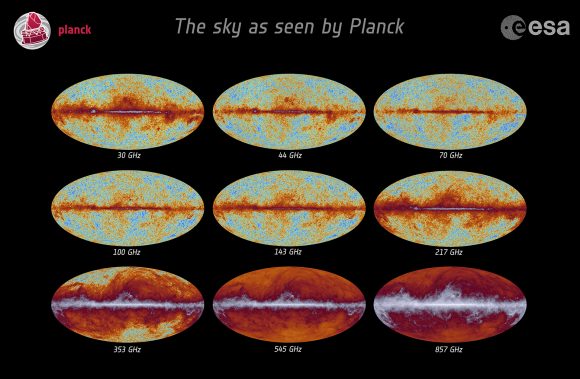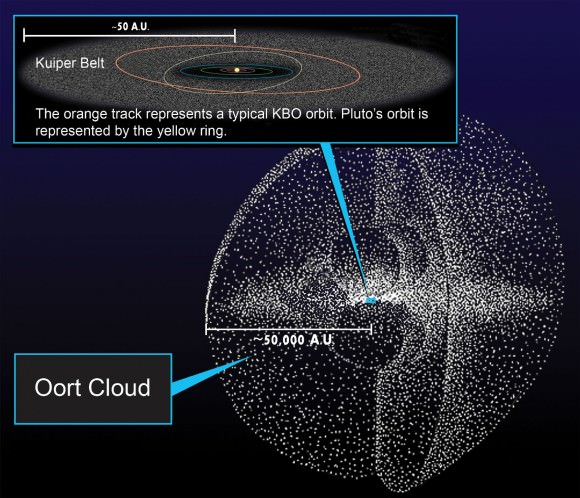For decades, scientists have theorized that beyond the edge of the Solar System, at a distance of up to 50,000 AU (0.79 ly) from the Sun, there lies a massive cloud of icy planetesimals known as the Oort Cloud. Named in honor of Dutch astronomer Jan Oort, this cloud is believed to be where long-term comets originate from. However, to date, no direct evidence has been provided to confirm the Oort Cloud’s existence.
This is due to the fact that the Oort Cloud is very difficult to observe, being rather far from the Sun and dispersed over a very large region of space. However, in a recent study, a team of astrophysicists from the University of Pennsylvania proposed a radical idea. Using maps of the Cosmic Microwave Background (CMB) created by the Planck mission and other telescopes, they believe that Oort Clouds around other stars can be detected.
The study – “Probing Oort clouds around Milky Way stars with CMB surveys“, which recently appeared online – was led by Eric J Baxter, a postdoctoral researcher from the Department of Physics and Astronomy at the University of Pennsylvania. He was joined by Pennsylvania professors Cullen H. Blake and Bhuvnesh Jain (Baxter’s primary mentor).
To recap, the Oort Cloud is a hypothetical region of space that is thought to extend from between 2,000 and 5,000 AU (0.03 and 0.08 ly) to as far as 50,000 AU (0.79 ly) from the Sun – though some estimates indicate it could reach as far as 100,000 to 200,000 AU (1.58 and 3.16 ly). Like the Kuiper Belt and the Scattered Disc, the Oort Cloud is a reservoir of trans-Neptunian objects, though it is over a thousands times more distant from our Sun as these other two.
This cloud is believed to have originated from a population of small, icy bodies within 50 AU of the Sun that were present when the Solar System was still young. Over time, it is theorized that orbital perturbations caused by the giant planets caused those objects that had highly-stable orbits to form the Kuiper Belt along the ecliptic plane, while those that had more eccentric and distant orbits formed the Oort Cloud.
According to Baxter and his colleagues, because the existence of the Oort Cloud played an important role in the formation of the Solar System, it is therefore logical to assume that other star systems have their own Oort Clouds – which they refer to as exo-Oort Clouds (EXOCs). As Dr. Baxter explained to Universe Today via email:
“One of the proposed mechanisms for the formation of the Oort cloud around our sun is that some of the objects in the protoplanetary disk of our solar system were ejected into very large, elliptical orbits by interactions with the giant planets. The orbits of these objects were then affected by nearby stars and galactic tides, causing them to depart from orbits restricted to the plane of the solar system, and to form the now-spherical Oort cloud. You could imagine that a similar process could occur around another star with giant planets, and we know that there are many stars out there that do have giant planets.”
As Baxter and his colleagues indicated in their study, detecting EXOCs is difficult, largely for the same reasons for why there is no direct evidence for the Solar System’s own Oort Cloud. For one, there is not a lot of material in the cloud, with estimates ranging from a few to twenty times the mass of the Earth. Second, these objects are very far away from our Sun, which means they do not reflect much light or have strong thermal emissions.
For this reason, Baxter and his team recommended using maps of the sky at the millimeter and submillimeter wavelengths to search for signs of Oort Clouds around other stars. Such maps already exist, thanks to missions like the Planck telescope which have mapped the Cosmic Microwave Background (CMB). As Baxter indicated:
“In our paper, we use maps of the sky at 545 GHz and 857 GHz that were generated from observations by the Planck satellite. Planck was pretty much designed *only* to map the CMB; the fact that we can use this telescope to study exo-Oort clouds and potentially processes connected to planet formation is pretty surprising!”
This is a rather revolutionary idea, as the detection of EXOCs was not part of the intended purpose of the Planck mission. By mapping the CMB, which is “relic radiation” left over from the Big Bang, astronomers have sought to learn more about how the Universe has evolved since the the early Universe – circa. 378,000 years after the Big Bang. However, their study does build on previous work led by Alan Stern (the principal investigator of the New Horizons mission).

In 1991, along with John Stocke (of the University of Colorado, Boulder) and Paul Weissmann (from NASA’s Jet Propulsion Laboratory), Stern conducted a study titled “An IRAS search for extra-solar Oort clouds“. In this study, they suggested using data from the Infrared Astronomical Satellite (IRAS) for the purpose of searching for EXOCs. However, whereas this study focused on certain wavelengths and 17 star systems, Baxter and his team relied on data for tens of thousands of systems and at a wider range of wavelengths.
Other current and future telescopes which Baxter and his team believe could be useful in this respect include the South Pole Telescope, located at the Amundsen–Scott South Pole Station in Antarctica; the Atacama Cosmology Telescope and the Simons Observatory in Chile; the Balloon-borne Large Aperture Submillimeter Telescope (BLAST) in Antarctica; the Green Bank Telescope in West Virgina, and others.
“Furthermore, the Gaia satellite has recently mapped out very accurately the positions and distances of stars in our galaxy,” Baxter added. “This makes choosing targets for exo-Oort cloud searches relatively straightforward. We used a combination of Gaia and Planck data in our analysis.”
To test their theory, Baxter and is team constructed a series of models for the thermal emission of exo-Oort clouds. “These models suggested that detecting exo-Oort clouds around nearby stars (or at least putting limits on their properties) was feasible given existing telescopes and observations,” he said. “In particular, the models suggested that data from the Planck satellite could potentially come close to detecting an exo-Oort cloud like our own around a nearby star.”

In addition, Baxter and his team also detected a hint of a signal around some of the stars that they considered in their study – specifically in the Vega and Formalhaut systems. Using this data, they were able to place constraints on the possible existence of EXOCs at a distance of 10,000 to 100,000 AUs from these stars, which roughly coincides with the distance between our Sun and the Oort Cloud.
However, additional surveys will be needed before the existence any of EXOCs can be confirmed. These surveys will likely involve the James Webb Space Telescope, which is scheduled to launch in 2021. In the meantime, this study has some rather significant implications for astronomers, and not just because it involves the use of existing CMB maps for extra-solar studies. As Baxter put it:
“Just detecting an exo-Oort cloud would be really interesting, since as I mentioned above, we don’t have any direct evidence for the existence of our own Oort cloud. If you did get a detection of an exo-Oort cloud, it could in principle provide insights into processes connected to planet formation and the evolution of protoplanetary disks. For instance, imagine that we only detected exo-Oort clouds around stars that have giant planets. That would provide pretty convincing evidence that the formation of an Oort cloud is connected to giant planets, as suggested by popular theories of the formation of our own Oort cloud.”
Further Reading: arXiv

